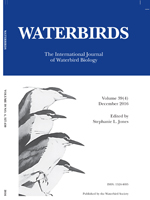Eared Grebes (Podiceps nigricollis) staging at the Great Salt Lake, Utah, USA, sometimes experience weather-induced downings where many individuals are killed. Downings of Eared Grebes moving south during the fall have been reported for decades; however, spring downings are rare and underrepresented in the literature. On 15 April 2013, 13,500 Eared Grebes flying northward encountered inclement weather, were attracted to lights on Dugway Proving Ground, and downed. This spring downing was documented, and population characteristics were compared with those observed in previous downings. An estimated 38% were killed outright. Rescue efforts promoted the survival of 88% of those not killed on impact. Grebes that were 9–10 months old were, on average, 10% lighter than adults in the same flight, perhaps indicating slow growth or age differences in foraging efficiency. Adults dominated all downings, supporting previous information that adults and young migrate on different schedules. The sex ratio in the North American population appears to be 1:1. Downings occur when Eared Grebes encounter inclement weather and are attracted to lights. Knowledge of the route, migration period, and flight speed of Eared Grebes allows predictions about when and where downings are likely to occur. Reducing the number and intensity of lights on snowy nights in high risk areas may decrease mortality.
How to translate text using browser tools
1 December 2016
Spring Downings Clarify the Migration Biology of Eared Grebes (Podiceps nigricollis)
S.Ellis Kristen,
R. Jehl Joseph,
Robert N. Knight,
Keeli S. Marvel,
Randy T. Larsen

Waterbirds
Vol. 39 • No. 4
December 2016
Vol. 39 • No. 4
December 2016
downing
Eared Grebe
Great Salt Lake
migration
mortality
Podiceps nigricollis




